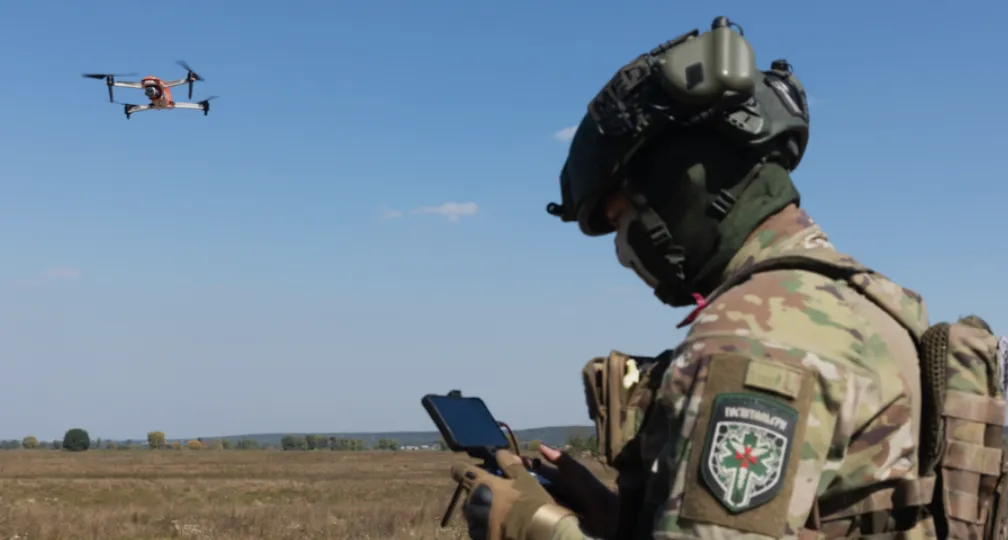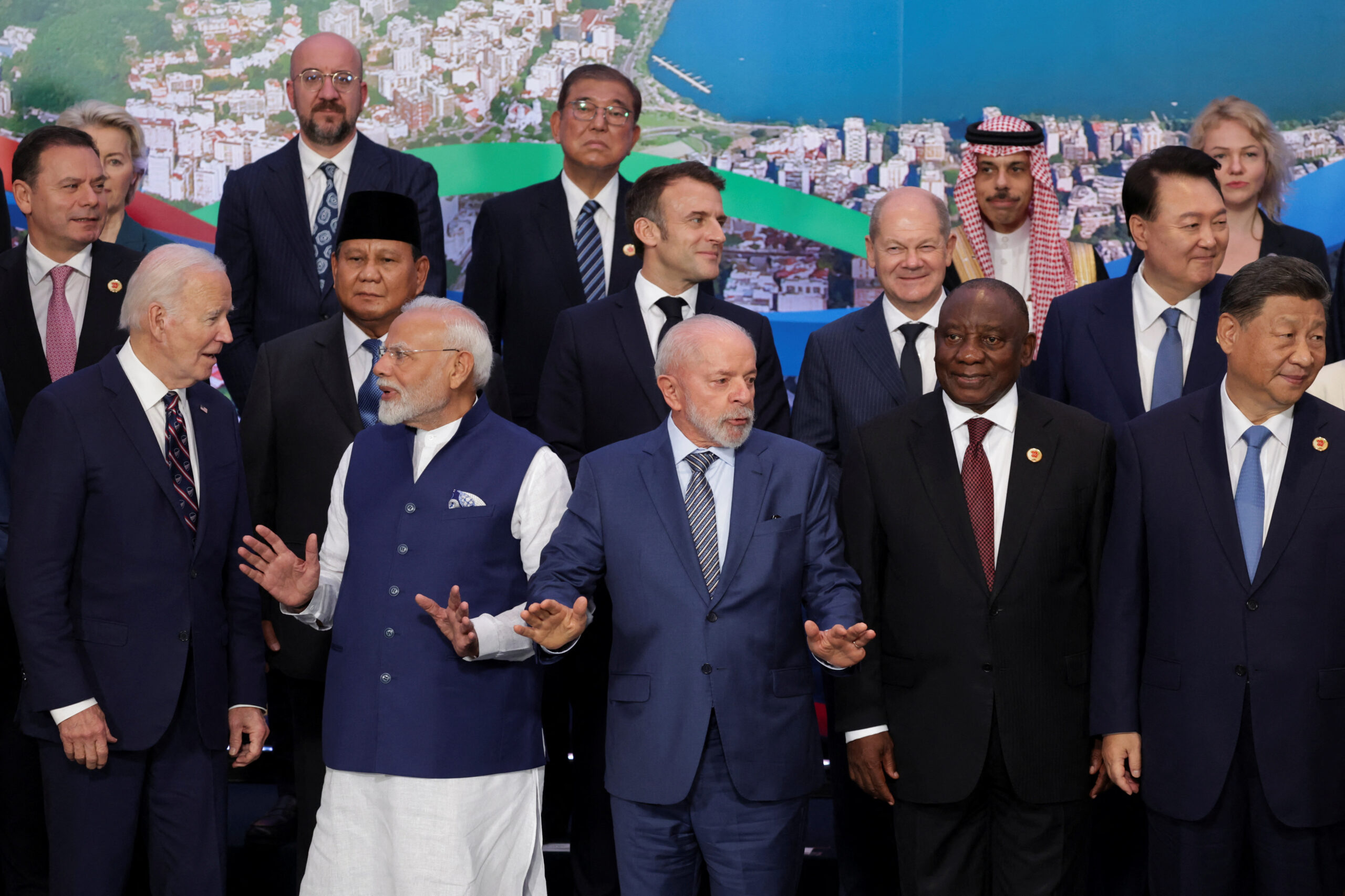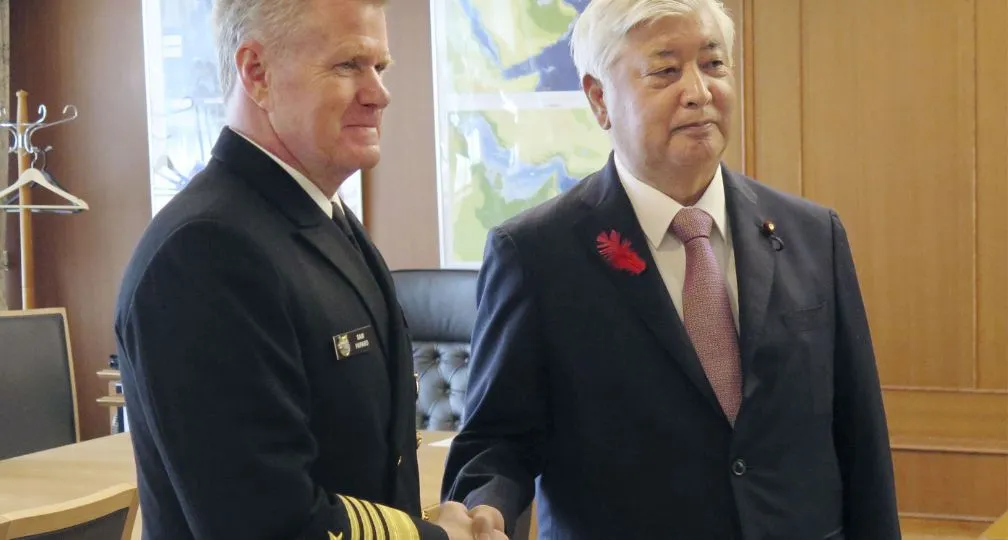War in Ukraine highlights importance of cutting-edge technology in conflict

Visiting Fellow, Asia Pacific Initiative
There are many factors behind the Ukrainian forces’ victory in some tactical missions in the Russia-Ukraine war, but the main factor would be the fact that they were relatively successful in equipping the entire military with cutting-edge technology.
The significance in the field of national security of “implementing” advanced technology in the military and what should be done by Japan to correspond to the new way of fighting using artificial intelligence both need to be examined.
Through the war in Ukraine, Kyiv’s troops have proved that asymmetric battles utilizing leading-edge technologies can work in a war against major powers like Russia.
Russia’s flagship cruiser Moskva was sunk in April after a strike by one of Ukraine’s latest surface-to-ship Neptune missiles.
It is also said that military equipment supplied by the United States, including the High Mobility Artillery Rocket System, contributed to Ukraine recovering much of the Kharkiv region in the eastern part of the country.
Precision-guided attacks from a distance using advanced technology are making asymmetric warfare by independent, dispersed and resilient small-scale forces possible.
However, we should also focus on the fact that what decides the course of the war is whether the entire military is effectively using cutting-edge technologies.
The war has highlighted that qualitative factors such as organizational culture can affect the degree of implementation of such technologies.
Hanna Shelest, security studies program director of the Ukrainian Prism think tank, said in a policy brief for the European Council on Foreign Affairs in November that one of the achievements of Ukraine’s transformation of its military forces following Russia’s invasion of Crimea in 2014 was the empowering of leadership skills of mid-level officers based on the adoption of NATO standards.
Shelest noted that in Crimea in 2014, many units of the Ukrainian military waited days for instructions from Kyiv, leading to poor performance.
Learning lessons from the experience, Ukraine adopted NATO practices to upgrade logistics, communications, troop operations and training.
Just like in Western countries, the Ukrainian military conducted operations and training focusing on nurturing competent leadership among non-commissioned officers, which enabled field commanders to make decisions spontaneously on the battlefield following Russia’s invasion.
According to Shelest, the Russian army, meanwhile, is heavily centralized and hierarchical. She cited military experts who said the Russian command has shown an unwillingness to delegate authority to junior officers.
Shelest said the Russian military has many high-ranking officers, and Russian generals tend to perform more function in combat. If they are attacked and a chain of command fails to function properly, units led by junior officers who lack initiative and have poor operational command skills are rendered inoperable.
Moreover, Ukraine has managed to make use of safe and stable communications through NATO’s provision of secure tactical communications systems and commercial satellite communications.
The Ukrainian military has also actively used civilian advanced technologies, conducting attacks using drones and short-distance intelligence, surveillance and reconnaissance (ISR), as well as collecting and analyzing publicly available information, including data from Russian social media and radio using artificial intelligence.
Such activities have enabled the military to employ appropriate situation awareness on the front line.
It is difficult to make evaluations on the war in Ukraine at this stage. But it is true that a number of think tanks are pointing to the possibility that the Russian military, which had been at an advantage both in terms of quality and quantity of weapons at the initial stage of the war, has not been able to make use of its capabilities due to qualitative factors such as organizational culture.
On the other hand, the Ukrainian military, while having gained the support of Western countries, appears to be utilizing cutting-edge technologies and other tools more effectively than its Russian counterpart.
It cannot be denied that the differences in the degree of implementing advanced technologies throughout the organization can have an impact on national security and whether the organization can make effective use of such technologies can be dependent on qualitative elements.
Modernizing militaries
Generally speaking, modernizing whole military organizations with cutting-edge technologies involves many difficulties.
“The Culture of Military Organizations,” edited by Peter Mansoor and Williamson Murray, states that military organizations are particularly slow to evolve culturally, as wholesale changes to proven war-fighting methods and reliable technology can bring about catastrophic consequences.
It says that for organizations involved in armed conflicts, radical change is potentially dangerous and always costly, and that, with the exception of defeat or other unusual pressures, organizational culture is elastic and even sluggish, operating under a coherent and highly restrictive mindset.
It can be said that while the Ukrainian military was able to reform itself with the 2014 Crimea crisis creating strong pressure to change, the Russian military did not have such an opportunity.
Western countries such as the U.S. are making innovative efforts to resolve such issues related to organizational culture and prepare for future warfare by providing advanced technologies for their troops.
In 2018, the U.S. Department of Defense established the Defense Innovation Unit (DIU) to accelerate the adoption and fielding of leading commercial technology throughout the military.
The DIU aims to move from problem identification to prototype contract award within 90 days.
The upper hand of AI
The final report of the U.S. National Security Commission on Artificial Intelligence (NSCAI) issued in 2021 indicates the possibility that advanced technologies used in modern warfare will be further strengthened by artificial intelligence.
The report warns that human operators will not be able to keep pace with AI-enabled threats such as cyberattacks, disinformation attacks, drone swarms or missile attacks. AI processes massive data at machine speed, so humans will need assistance from AI.
By combining different ways of utilizing AI, it will become possible in the future to use AI-installed drones to conduct ISR activities, analyze and evaluate collected information, and launch attacks.
In other words, it will become possible to incorporate AI into every step of the so-called OODA (observe, orient, decide and act) loop, a decision-making cycle applied to the combat operations process.
Such a future is quickly becoming a reality, and the U.S. is paying close attention to China’s moves.
The U.S. Department of Defense, in its 2022 China Military Power Report released in November, pointed out that Beijing focuses on AI as a technology to improve the speed and quality of information-processing by reducing battlefield uncertainty and providing decision-making advantage over potential adversaries.
According to the report, China is also researching various applications for AI, including support for missile guidance, target detection and identification, and autonomous systems, as well as exploring next-generation operational concepts for intelligent warfare, such as attrition warfare by intelligent swarms.
The U.S. and the United Kingdom, recognizing that AI, combined with other advanced technologies, can change future warfare, each compiled a defense AI strategy and a data strategy for defense.
Based on those strategies, both countries are developing and introducing AI and digital infrastructure to operate the technology.
Through such efforts, they are aiming to establish an AI-ready military organization, meaning a data-driven organization for which AI can be applied through all of its functions.
The ethical issue of autonomizing all combat activities is being debated globally, but we must acknowledge the fact that it is technologically feasible.
This means Japan should also consider introducing AI throughout its defense forces under the recognition that AI can change the way of fighting a war.
An overall shift in mindset
Japan revised its three strategic documents related to security on Dec. 16, and active discussions are taking place on acquiring new defense equipment.
However, as the war in Ukraine indicates, it is also necessary to consider how to apply those advanced technologies to a country’s armed forces as a whole.
AI, combined with cutting-edge technologies, may change the nature of warfare in the future.
Taking into account moves by other countries, Japan will have to think about applying AI to the seven key measures identified by the Defense Ministry as necessary to strengthen defense capabilities, including furnishing the Self-Defense Forces (SDF) with “stand-off” capabilities — the capability to strike adversarial invasion forces by using standoff weapons from outside the ranges of the adversary’s attack.
Moreover, Japan must take into consideration the possibility of the U.S. requesting its allies to be AI-ready in order to build an integrated deterrence posture with them.
The NSCAI report points out that uneven adoption of AI will threaten military interoperability and the political cohesion and resiliency of U.S. alliances.
This indicates that Japan must also work on having AI-ready defense capabilities in line with efforts made by the U.S. and the U.K.
In order to make such efforts, Japan will have to create a foundation to be equipped with AI, which could extend reforming organizational structure and culture of the SDF, the core of the nation’s defense power.
To become AI-ready, it is necessary to digitize all the information handled by the organization and create machine-readable databases.
Moreover, the organization must have a structure and culture that can utilize AI-processed analyses and evaluations to make decisions.
Therefore, it is important to first have a clear vision of how to apply AI to defense capabilities and how to reform the organization to realize the goal.
Efforts to apply advanced technologies to defense capabilities might be inconspicuous compared with acquiring new key defense equipment or budgets.
However, the war in Ukraine has already demonstrated the fact that such efforts are as important as or even more significant than obtaining or being equipped with new weapons.
(Photo Credit: Shutterstock)

Geoeconomic Briefing
Geoeconomic Briefing is a series featuring researchers at the IOG focused on Japan’s challenges in that field. It also provides analyses of the state of the world and trade risks, as well as technological and industrial structures (Editor-in-chief: Dr. Kazuto Suzuki, Director, Institute of Geoeconomics (IOG); Professor, The University of Tokyo).
Disclaimer: The opinions expressed in Geoeconomic Briefing do not necessarily reflect those of the International House of Japan, Asia Pacific Initiative (API), the Institute of Geoeconomics (IOG) or any other organizations to which the author belongs.
 The Lessons of the Nippon Steel Saga2025.07.08
The Lessons of the Nippon Steel Saga2025.07.08 From dollar hegemony to currency multipolarity?2025.06.25
From dollar hegemony to currency multipolarity?2025.06.25 The Big Continuity in Trump’s International Economic Policy2025.06.11
The Big Continuity in Trump’s International Economic Policy2025.06.11 India’s Strategic Autonomy in a Trumpian World2025.07.11
India’s Strategic Autonomy in a Trumpian World2025.07.11 The Tyranny of Geography: Okinawa in the era of great power competition2024.02.09
The Tyranny of Geography: Okinawa in the era of great power competition2024.02.09
















